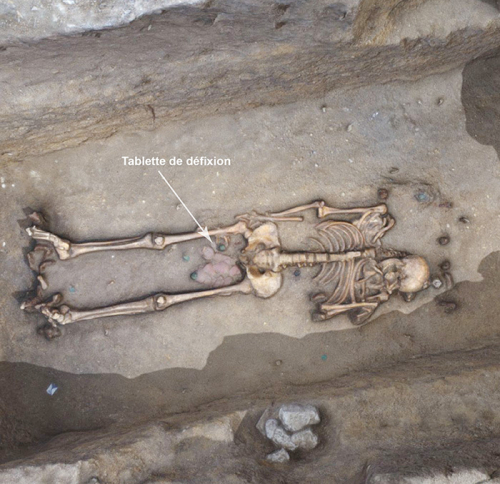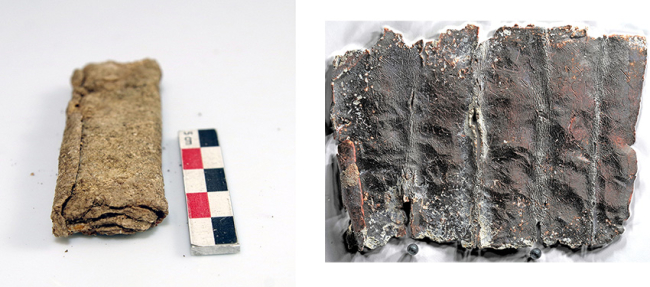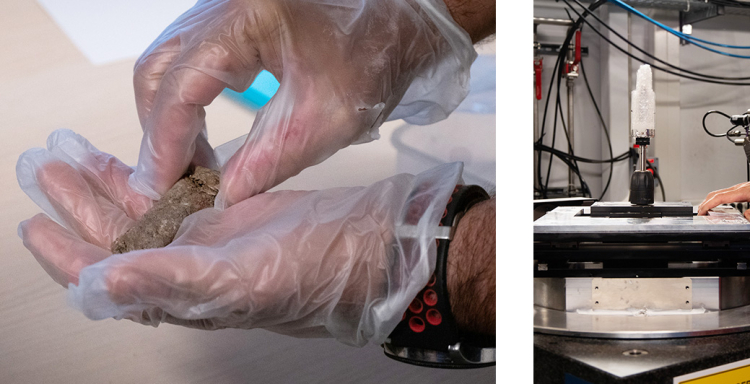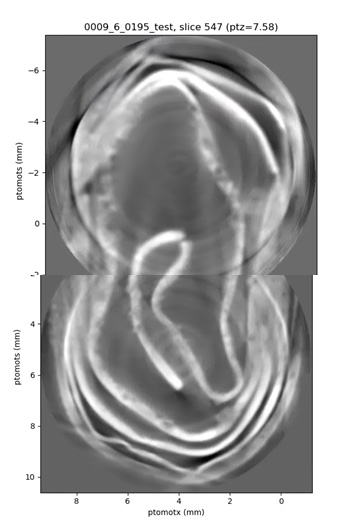Archaeological excavations carried out between 2022 and 2024 at the site of the former Porte Madeleine hospital in Orléans by the Archaeological Service of the City of Orléans uncovered a previously unknown Roman-era necropolis. The graves contained 18 lead curse tablets (in Latin: tabella defixionis, defixio, meaning enchantment or curse), folded or rolled upon themselves.
To access the inscriptions on these tablets without risking damage by unfolding them, the archaeologists turned to the PSICHE beamline team.
This necropolis exhibits numerous unique characteristics compared to other burial sites of the same period. All the graves are inhumations, arranged in a single row along a boundary wall, stretching over at least 140 meters. All of the individuals found are adult males, buried in wooden coffins, the iron nails of which were recovered. The identity of the deceased remains a mystery, but the layout of the necropolis and the uniformity of the burial practices suggest to the archaeological team that this could be a group linked to a specific population or corporation: perhaps officials, magistrates, or a merchant guild?
Several of these graves contained curse tablets—very thin lead plaques inscribed with messages or symbols, then rolled or folded (figure 1). The use of lead is both practical and symbolic: easily malleable and engravable, this cold metal symbolizes the depths of the earth and chthonic deities (underworld and earth gods, as opposed to celestial gods). These tablets are most often found in wells, springs, or funeral contexts. They typically carry curses or, in some cases, white magic, always tied to an appeal to the gods.

Figure 1: The F2199 grave uncovered in the necropolis; the arrow points to the location of the associated curse tablet (© Archaeology Service, 2022).
At the Porte Madeleine necropolis in Orléans, no fewer than 18 curse tablets have been unearthed, making this an exceptional collection for such a context. Two tablets from the site’s initial 2022 excavation have been unfolded, revealing inscriptions in Latin cursive, one written in the Gaulish language and the other in Latin. Unfolding the tablets, done by a heritage conservator (figure 2), always involves some risk to the integrity of the object, as cracks often appear along the folds, complicating subsequent transcription of the text.

Figure 2: Left, the curse tablet found folded in the F2199 grave, the scale rule measures 5 cm (© Archaeology Service, 2023); right, the unfolded and restored curse tablet from the F2199 grave, photographed using RTI* technology (© Antoine Cazin, La Fabrique de Patrimoine en Normandie, 2023).
The idea here is to attempt to read one of the curse tablets without even unfolding it, using X-ray tomography on the PSICHE beamline at the SOLEIL synchrotron, a technique similar to a medical scanner. After recording 3D images, the "virtual unrolling" of the scanned object is performed through a long process of reconstructing flat images, based on a custom image processing program specifically adapted to the object. This tailor-made reconstruction (depending on the degree of coil tightness, etc.) is carried out by Andrew King, a scientist on the PSICHE beamline. This approach has already yielded impressive results on a Mandean talisman to be exhibited in the future Musée des Ecritures in Ampus (Var), results that have been noted by the Orléans team.
.
Test-measurements carried out at PSICHE beamline
The first test measurements carried out in early October 2024 (figure 3) demonstrated the feasibility of the study.

Figure 3: the curse tablet, on the left, is fixed to the sample holder in the PSICHE beamline's experimental hutch (right) after being protected in a plastic envelope to avoid any risk of impact. The sample holder is then remotely controlled to position and rotate the tablet in the X-ray beam.
The results obtained are very promising (figure 4) and PSICHE scientists already have ideas for strategies to improve contrast and resolution in future measurements with the Orléans team.
See you soon!

Figure 4: Two overlapping X-ray tomography scans of the tablet, collected on PSICHE; the image corresponds to a section of the tablet (approx. 1.5 cm x 0.5 cm). The internal folding of the tablet is revealed.
*RTI: Reflectance Transformation Imaging, photographic method for producing a dynamic image from a series of shots taken at multiple light angles. Software processing is used to create a model of the photographed object and dynamically modify the location of the light source. Details invisible to the naked eye or in natural light can thus be highlighted (Source).
